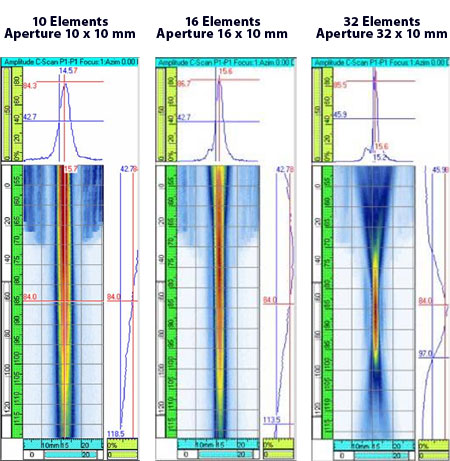Focusing With Phased Array Probes
From the beam spread angle, the beam diameter at any distance from the transducer can be calculated. In the case of a square or rectangular phased array transducer, beam spreading in the passive plane will be similar to that of an unfocused transducer. In the steered or active plane, the beam can be electronically focused to converge acoustic energy at a desired depth. With a focused transducer, the beam profile can typically be represented by a tapering cone (or wedge in the case of single-axis focusing) that converges to a focal point and then diverges at an equal angle beyond the focal point, like this:
The near field length and hence the natural divergence of an ultrasonic beam are determined by aperture (equal to element diameter in the case of conventional monolithic transducers) and wavelength (wave velocity divided by frequency). For an unfocused transducer, the near field length, beam spread angle, and beam diameter can be calculated as follows:

The near field length in a given material also defines the maximum depth at which a sound beam can be focused. A beam cannot be focused beyond the end of the near field.
A focused transducer's effective sensitivity is affected by the beam diameter at the point of interest. The smaller the beam diameter, the greater will be the amount of energy that will be reflected by a small flaw. The -6 dB beam diameter of a focused transducer at the focal point can be calculated as follows:
![]()
From these formulas it can be seen that as the element diameter and/or frequency increase, the beam spread angle decreases. A smaller beam spread angle in turn can result in higher effective sensitivity in the far field zone since the beam energy dissipates more slowly. Within its near field, a transducer can be focused to create a beam the converges rather than diverges. Narrowing the beam diameter to a focal point increases sound energy per unit area within the focal zone and thus increasing
sensitivity to small reflectors. Conventional transducers usually do this with a refractive acoustic lens, while phased arrays do it electronically by means of phased pulsing and the resulting beam shaping effects.
In the case of the most commonly used linear and square phased arrays with rectangular elements, the beam will be focused in the steering direction and unfocused in the passive direction. Increasing the aperture size increases the sharpness of the focused beam, as can be seen in these beam profiles. Red areas correspond to the highest sound pressure, and blue areas to lower sound pressure.

Continue on to
Phased Array Probe Selection Summary >>